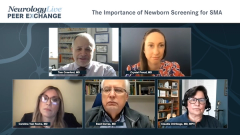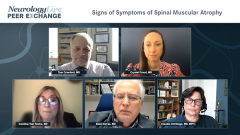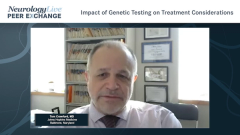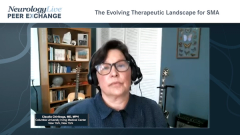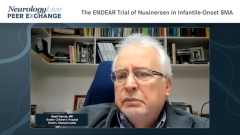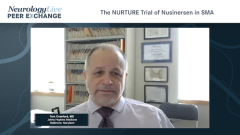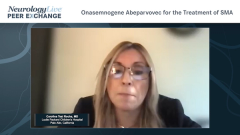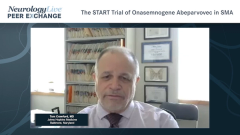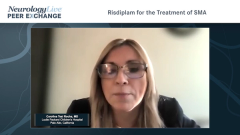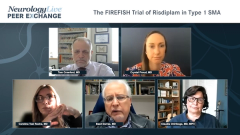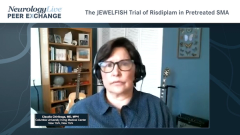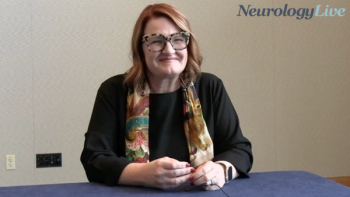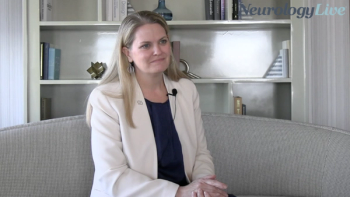
The Importance of Newborn Screening for SMA
A panel of key opinion leaders in neurology considers the importance of newborn screening for spinal muscular atrophy in order to start patients on treatment as early as possible.
Episodes in this series

Crystal Proud, MD: I would like to turn now to Claudia and see if you can discuss for us the ways that we screen newborns for spinal muscular atrophy (SMA).
Claudia A. Chiriboga-Klein, MD, MPH: Yes, of course. Thank you for the question, Crystal. As you know, the Recommended Uniform Screening Panel, in the summer of 2018, recommended the introduction of SMA into the newborn screening. These are the heel stick tests that are done routinely and have been done for various metabolic disorders, but they now include testing for SMA, given the genetic tests that are so accurate. The last numbers I have are from Cure SMA, which drew data from 34-plus states that have introduced it; about 68% of the population of newborns in the United States are being screened. The way it is administered varies across states because it is state-dependent. I can talk to you about New York, but the uniform part of it is that they all screen for the SMN1 gene, and then the data are transferred to a provider. In many cases, it is transferred to a multidisciplinary clinic.
For example, in New York, they identified centers of excellence, which are sites that treat patients with SMA. The difference with New York, for example, is that they include the SMN2 copy number that Tom was referring to, which is very important in terms of identifying how severe the phenotype might be, especially for those infants with 2 SMN2 copy numbers. You are working against the clock because they probably have subclinical loss, and we have seen that with the NURTURE study and with the SPR1NT study, which examined onasemnogene therapy in presymptomatic SMA. By the way, Tom, I like your classification in the era of preclinical treatment. I think we have to identify if treatment is presymptomatic or symptomatic, and how advanced our patients who are symptomatic are, because the phenotypes, if we are lucky, will not be useful to determine the genetic burden that we are dealing with.
Once the SMN1 gene copy is confirmed by the site, then you can decide how to treat the patient. The main reason for the confirmation, at least in New York, where they double test the SMN1 gene copy, is to ensure that the patient is the right patient and that there has not been a mix-up. That ties into the diagnosis, and then you can proceed with identification of what is the best approach for treatment. Of course, it behooves you, when the child is referred to you as part of this presymptomatic evaluation, to run all your tests very early so you can decide on treatment early enough. That has to do with all the criteria that are needed for any of the therapies you are considering that have any exclusionary factors, so you can decide which is the best approach at that time.
Thomas Crawford, MD: To add one little thing, I think we neurologists have a call to arms to make certain that the newborn screening program is more broadly applied. Any place where they are going to be treating patients with these expensive drugs, it is vastly better to treat them early than it is to treat them later—and it is better if it is not cheaper, if they are going to indeed be diagnosed and treated. This is especially true internationally, as more and more states are coming online. That is great. There are countries around the world that use these expensive therapies but do not do so until after the kids are gravely damaged, and so the newborn screening program is cheap in that context.
Carolina Tesi Rocha, MD: I would like to add that, in the case that Claudia was mentioning, the reports go to the neurologist or the centers of excellence for the treatment of neuromuscular conditions. In some cases, however, such as in California, the notification goes initially to a pediatrician. The neurologists are notified, but the pediatrician is the one who has the ability to communicate with the families and refer them to the centers of neuromuscular care. It is so important to raise the awareness among pediatricians about the newborn screening and the importance of early recognition.
Thomas Crawford, MD: Not every state’s program has a defined way in which they chase after folks to see that something was done with a notification, so this is another area where there has to be vigilance.
Basil Darras, MD: I can add something; the definition of the term “infant” is not very good in some of the FDA labels, and we have to be very careful with that. I recently had a case where they were waiting for the child to come to term at 40 or 41 weeks, and the baby was born at 36. Instead of starting treatment right away, they were waiting a month to treat the child—5 weeks I think—and the child developed symptoms in the interim, became hypotonic, lost reflexes, and became symptomatic. I think it is important to keep in mind that we have to treat very early—as early as 37 weeks of gestation, I think.
Crystal Proud, MD: That is a great point.
Thomas Crawford, MD: Well, we know that with the disease, patients with 2 copies are accumulating damage long before they are manifesting weakness. We will get into that a little later, but there is no doubt that that silent period is not silent.
Crystal Proud, MD: Thank you for watching this NeurologyLive® Peer Exchange. If you enjoyed the content, please subscribe to our e-newsletters to receive upcoming Peer Exchanges and other great content right in your inbox.
Transcript Edited for Clarity
Newsletter
Keep your finger on the pulse of neurology—subscribe to NeurologyLive for expert interviews, new data, and breakthrough treatment updates.

